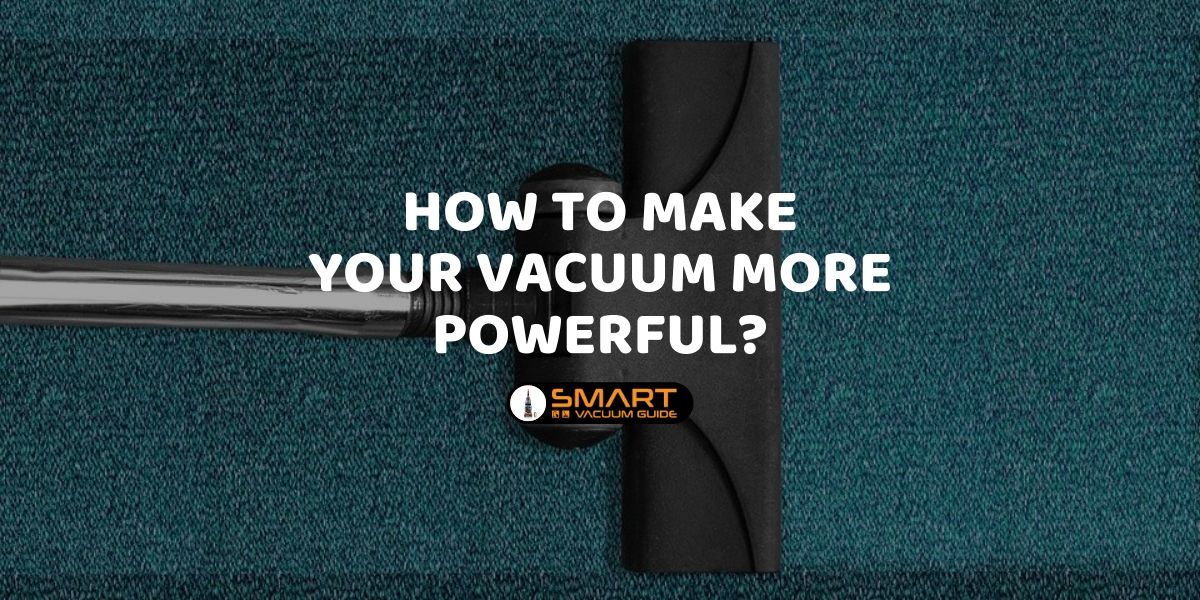The thought of how vacuum cleaners actually work hardly ever crosses most people’s minds. Especially when they have a brand new bright and shiny vacuum cleaner standing in front of them. One that is powerful enough to do the job effectively that they want it to do.
Until it, loses either power or stops working completely and we are left with that awful feeling of not knowing what to do. Then our minds start to fill up with many different questions. Questions like do we need a new vacuum, have we been using it right, are there ways we can repair it and why do vacuums lose suction?
But before we help you to answer some of these questions. You need to understand a little about the power of a vacuum cleaner and how it works. This knowledge will help you to understand why vacuum loses its power and what you can do to fix it.
In this article, we cover in simple terms how vacuum cleaners get their power. We also include a checklist about how to make your vacuum more powerful when it starts to lose it.
The Power of a vacuum cleaner

SmartVacuumGuide
The power of vacuum cleaners is usually indicated by the manufacturer on the specifications of a vacuum cleaner in Watts. It is a common mistake made by many people to buy a product only according to the number of watts the vacuum can offer.
However, the higher the watts do not mean the more suction power the vacuum cleaner has. It only means the amount of energy the vacuum will consume when switched on.
So if not the watts, then what does determine how powerful your vacuum is?
This would be the air watts of the vacuum cleaner which is the specification that shows how strong the suction is. Let us briefly look at the suction power of a vacuum.
The Suction Power of a vacuum
The suction power of a vacuum cleaner determines the performance of a vacuum cleaner. This performance of a vacuum is how well it sucks up the dust and dirt. Known as suction where it then transports it using air, known as the airflow to the dirtbag or canister.
The suction is often referred to as the water lift of a vacuum and is measured in inches. And the airflow is referred to as the CFM that is measured in cubic feet per minute.
The majority of the commonly bought vacuum cleaners offer an airflow of 50 to 100 CFM. The larger this number is, the greater the cleaning power will be.
Another specification that a vacuum cleaner might mention is Airspeed. It is generally shown as meters per second and the faster this is, the higher the cleaning power it has.
Now that you understand a little about how the suction power and power of a vacuum cleaner works. It should become a little more obvious that the problem could be with the other parts of the vacuum. These problems could be affecting the airflow in the vacuum in some way.
You now have two options to choose from to solve your question, how to make your vacuum more powerful? The first option will cost you some money and the second option is free but takes a little work of your own. Either your choice is to take it to a vacuum cleaner repair shop or you can go through the checklist we that have provided below to do it yourself.
Do it yourself Checklist
The main cause of loss of suction power is usually due to something small and can easily be fixed. Something like cracks, tears, damages, and blockages to certain parts of the vacuum cleaner. Below are the things that you could check that would help you to improve your vacuum cleaner suction power. They are:
- The vacuum is set on the correct setting for the type of floor you need to vacuum
- The dirtbag or canister is not too full and may need emptying or replacing
- Check the hose for any cracks, breaks or blockages
- Inspect the filter for any tears, cracks or buildup of dust or dirt
- If your type of vacuum uses a belt for rotating the brushes or rollers, make sure that the belts are not worn and broken
- Check if the rollers on your vacuum need cleaning
- Make sure that the hose, dirtbag or canister, filters, and other attachments are attached correctly and are airtight
Solving just one or all the above issues could help make your vacuum cleaner be more powerful. It will start to work again just like the first day when you brought it home from the shop, brand new.
But, any of the above issues can also be the reason why your vacuum cleaner is blowing out dust. It could also be the answer to why my vacuum cleaner is spitting out dirt.
So just to be clear if your vacuum cleaner is not picking up any dirt, blowing out dust, or is spitting out the dirt, it could be because of reduced suction power. The reason for this is usually because there is very little or no airflow at all. It is more likely due to a clog somewhere in your system or your filter needs to be washed and cleaned or replaced.
If you are still experiencing a loss of suction power and you have run through the checklist. You have made sure that there are no damages, clogs, full dirtbags, or dirty filters. Then it might be time to take your vacuum cleaner in for repairs. Another option would be to buy a newer one with better suction power from a good brand. For example a shark vacuum, a Dyson, or a Bissell vacuum cleaner.
With this article, we hope, you have gained a little extra knowledge as to how the power of a vacuum cleaner works. We have helped you answer your question about how to make your vacuum more powerful by following the checklist that we have provided for you.
You Might Also Like:
[tcb_post_list query=”{‘paged’:1,’filter’:’related’,’related’:|{|’category’|}|,’orderby’:’date’,’order’:’DESC’,’posts_per_page’:’10’,’offset’:’1′,’no_posts_text’:’There are no posts to display.’,’exclude_current_post’:|{||}|,’queried_object’:{‘ID’:439,’post_author’:’3′,’post_type’:’post’}}” type=”list” columns-d=”1″ columns-t=”1″ columns-m=”1″ vertical-space-d=”15″ horizontal-space-d=”30″ ct=”post_list-44441″ ct-name=”Image and text 16″ tcb-elem-type=”post_list” pagination-type=”load_more” pages_near_current=”2″ css=”tve-u-171c4e93e60″ vertical-space-t=”30″ element-name=”Post List” article-tcb_hover_state_parent=”” vertical-space-m=”15″ total_post_count=”16″ total_sticky_count=”0″ posts_per_page=”10″ featured-content=”0″ no_posts_text=”” disabled-links=”0″ featured-list=”tve-u-171ad711190″ article-shortcode=”tcb_post_list” class=” article-tcb_hover_state_parent=” article-shortcode=’tcb_post_list’ ][tcb_post_list_dynamic_style]@media (min-width: 300px){[].tcb-post-list #post-[tcb_the_id] []{background-image: url(“[tcb_featured_image_url size=large]”) !important;}[].tcb-post-list #post-[tcb_the_id] []:hover []{background-image: linear-gradient(rgba(0, 143, 255, 0.1), rgba(0, 143, 255, 0.1)), url(“[tcb_featured_image_url size=large]”) !important;}}[/tcb_post_list_dynamic_style][tcb_post_title css=’tve-u-171c4e93e76′ link=’1′ rel=’0′ target=’0′ inline=’1′ static-link='{“className”:””,”href”:”#”,”title”:”How to Make Your Vacuum More Powerful?”,”data-css”:”tve-u-171c4e93e76″}’ link-css-attr=”tve-u-171c4e93e76″]
[tcb_post_published_date css=” date-format=’F j, Y’ date-format-select=’F j, Y’ link=’1′ rel=’0′ show-time=’0′ target=’0′ time-format=” time-format-select=’g:i a’ type=’published’ inline=’1′ static-link='{“className”:””,”href”:”https://www.smartvacuumguide.com/2020/04/”,”title”:”April 29, 2020 “}’]
[tcb_post_content size=’words’ read_more=’….Continue Reading’ words=’23’ css=’tve-u-171c4e93e68′][/tcb_post_list][tcb_pagination data-list=’tve-u-171c4e93e60′ data-type=’load_more’]Load More[/tcb_pagination]Load More- How to Change Belt on Shark Vacuum - June 21, 2021
- Shark Vacuum Brush Roll Indicator Light Not on - June 21, 2021
- Shark Vacuum Not Turning on - June 21, 2021

